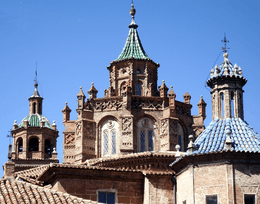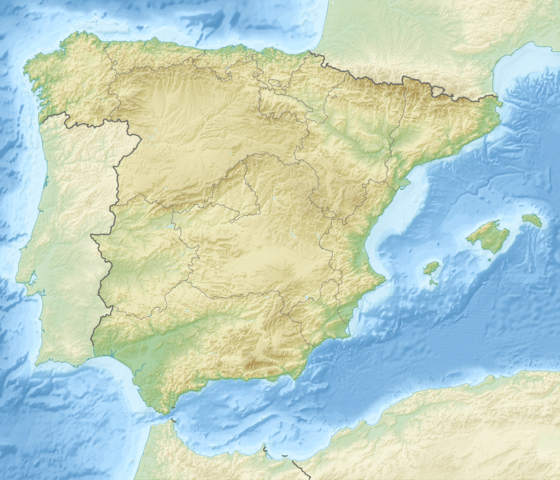Mudéjar Architecture of Aragon
| UNESCO World Heritage site | |
|---|---|
 Dome of the Cathedral of Teruel | |
| Location | Aragon, Spain |
| Includes | 10 sites in Teruel, Calatayud, Cervera de la Cañada, Tobed and Zaragoza |
| Criteria | Cultural: (iv) |
| Reference | 378ter |
| Inscription | 1986 (10th Session) |
| Extensions | 2001, 2016 |
| Area | 4.269 ha (0.01648 sq mi) |
| Buffer zone | 20.063 ha (0.07746 sq mi) |
| Coordinates | 40°20′38″N 1°06′26″W / 40.34389°N 1.10722°W |
 Location of Mudéjar Architecture of Aragon in Spain | |
Mudéjar Architecture of Aragon is an aesthetic trend in the Mudéjar style, which is centered in Aragon (Spain) and has been recognized in some representative buildings as a World Heritage Site by UNESCO.
The chronology of the Aragonese Mudejar occupies 12th to the 17th century and includes more than a hundred architectural monuments located predominantly in the valleys of the Ebro, Jalón and Jiloca.
The first manifestations of Aragonese Mudejar have two origins: on the one hand, a palatial architecture linked to the monarchy, which amends and extends the Aljafería Palace maintaining Islamic ornamental tradition, and on the other hand, a tradition which develops Romanesque architecture using brickwork rather than masonry construction and which often displays Hispanic-rooted ornamental tracery. Examples of the latter type of mudejar architecture can be seen in churches in Daroca, which were started in stone and finished off in the 13th century with Mudejar brick panels.
From the construction point of view, the Mudéjar architecture in Aragon preferably adopts functional schemes of Cistercian Gothic, but with some differences. Buttresses are often absent, especially in the apses which characteristically have an octagonal plan with thick walls that can hold the thrust from the roof and which provide space to highlight brick decorations. On the other hand, buttresses are often a feature of the naves, where they may be topped by turrets, as in the style of the Basilica of Our Lady of the Pillar. There may be side chapels which are not obvious from the exterior. Churches in neighborhoods (such as San Pablo of Zaragoza) or small towns do not usually have aisles, but locations for additional altars are provided by chapels between the nave buttresses. It is common for these side chapels to have a closed gallery or ándite (walkway), with windows looking to the outside and inside of the building. This constitution is called a church-fortress, and his prototype could be the church of Montalbán.
Typically the bell towers show extraordinary ornamental development, the structure being inherited from the Islamic minaret: quadrangular with central pier whose spaces are filled via a staircase approximation vaults, as in the Almohad minarets. On this body stood the tower, usually polygonal. There are also examples of octagonal towers.
World Heritage Site

In 1986, Unesco declared the whole Mudejar complex of Teruel a World Heritage Site,[1] which was extended in 2001 to include other Aragonese Mudejar monuments:
| Code | Name | Place | Year |
|---|---|---|---|
| 378-001 | Tower, roof and dome of the Cathedral of Saint Mary of Mediavilla | Teruel | 1986 |
| 378-002 | Tower and church of San Pedro | Teruel | 1986 |
| 378-003 | Tower and church of San Martín | Teruel | 1986 |
| 378-004 | Tower and church of The Savior | Teruel | 1986 |
| 378-005 | Apse, cloister and tower of Colegiata de Santa María | Calatayud | 2001 |
| 378-006 | Parish church of Santa Tecla | Cervera de la Cañada | 2001 |
| 378-007 | Church of Saint Mary | Tobed | 2001 |
| 378-008 | Mudéjar remains of the Palace of Aljafería | Zaragoza | 2001 |
| 378-009 | Tower and Parish church of San Pablo | Zaragoza | 2001 |
| 378-010 | Apse, parish and dome of La Seo | Zaragoza | 2001 |
The description of the importance given so appropriated:

Cite:
The development in the twelfth century Mudejar art in Aragon is a consequence of the political, social and cultural conditions that prevailed in Spain after the Reconquista. This art, influenced by Islamic tradition, also reflects various contemporary European styles, particularly Gothic. Present until the beginning of the seventeenth century, is characterized by extremely refined and inventive use of brick and glazed tiles in architecture, especially in church steeples.|
Aragonese Mudejar statement on the official website of UNESCO.
The justification for the statement is supported by the standard IV of the same organization:
Criterion IV.
Cite:
As an outstanding example of a type of building, architectural or technological ensemble or landscape which illustrates a significant period in human history.
Selection criteria (UNESCO, World Heritage Site).
See also
- List of Mudéjar buildings in Aragon: include non-World Heritage Sites.
References
- ↑ Mudejar Architecture of Aragon Website of UNESCO World Heritage Centre
Bibliography used
- Gonzalo Borrás Gualis, Mudejar art in Teruel, Teruel Studies Institute, 1990. ISBN 84-86982-22-7.
External links
| Wikimedia Commons has media related to Mudéjar architecture in Aragon. |
- UNESCO 'Aragon' World Heritage website
- Aragonese Mudejar Art, a complete book of Joseph Galiay Sarañana which is available free on the website of the Institution "Fernando el Católico."
- Aragonese Mudejar in the Government of Aragon website.
- Alphabetic index of Aragonese Mudejar.
- Aragonese Mudejar buildings belonging to the renowned World Heritage Site by UNESCO
- Online guide of Mudejar Aragonese Art.